This is my second product test on Free Product Road Testing program by Farnell. This time the tested product is fused test leads for multimeter (Farnell Number: 428-4276).
Why Fused Leads?
You might ask why test leads need be fused. Trust me there are situations where this is a really good idea. Maintenance of electrical and electronic equipment exposes the technician to potentially lethal voltages and short circuit current. Multimeter have fuses inside them, but those fuses do not always provide enough protection. Stock Multimeter Explosion video illustrates what happens when the fuse inside multimeter is not enough protection. This failure takes place in milliseconds and leaves very little time to react to the mistake as you can see in the picture below (image capture from Stock Multimeter Explosion video).
If you plug the leads in the wrong spot or have the wrong settings this is what can happen. It all depends on the interrupting capacity of the fuse on the meter. Very many multimeters have cheap fuses that can’t interrupt high current fault. Most commonly used 5x20mm glass fuses often seen in cheap multimeters have a low breaking capacity which generally restricts them to applications of 15 A or less at 250 VAC (Bussman fuse specifications say interrupting rating 35A at 250V for 32mA – 3.15A fuses). Ceramic fuses have the advantage of a higher breaking capacity due sand fill inside fuse body, but they cost considerably more than basic fuses. Not all fuses of the same amperage and voltage rating are the same! Unless a meter was specifically designed to meet CAT III-600 V or higher, it is not safe to use on power circuits.
Fused probes provide an additional level of measurement protection when making voltage or current measurements. It is safest is to use fused probes that have fuses with high enough interrupting capacity. Excessive current drawn through test probes, leads and measuring instruments can happens when a multimeter is set to the wrong function, eg. set on a current or resistance range when you should measuring voltage. circuit. But luck is not much to count on, especially when you could avoid the problem altogether by using the proper fuse.
The short circuit currents on electrical systems can he huge. If you take a CAT III 1000 V meter with the test leads in the amps jacks, you will have a series resistance of approximately 0.1 ohms between the leads. If you accidentally place the leads across an ideal 1000 volt source, you will generate a current of 10,000 amps. In real life electrical systems the electrical distribution network impedance will limit the current to somewhat lower but still huge (short circuit current easily 20-100 times higher than normal current on the circuit). This huge current can cause serious damage including multimeter explosion and test leads start to melt in very short time. When you can’t count on the multimeter to have the proper fuse, the best idea it to get fused probes that for sure have proper fuses in them. When you make that simple mistake of putting voltage across the current jacks and blow the fuse, you’re at first thankful you didn’t wipe out the meter or get hurt.
ESA commissioned a series of tests to simulate the impact of using fused leads as a protective measure. Fused leads used with multimeters prevented possible catastrophic results when the meter was used in an inappropriate way or experienced an internal failure. Fused leads worked as a safety mechanism in 90% of simulated tests. Eventually everyone tries to measure volts with the amperage setting. With a good fused multimeter probes (and other necessary safety accessories) you won’t do any serious damage. Adding to the user error problem is wear, tear and contamination within the meter that creates internal component failures or compromises the components’ dielectric properties. Multimeter Accident Prevention Plan, An Electrical Inspector’s Survival Guide article tells how people working with electricity are getting hurt using multimeters and how to eliminate or limit the risk.
British HSE guidance GS 38 (mentioned on fused probe documentation) and Canadian Electrical Safety Authority (ESA) drive to adopt fused test leads as an added safety measure for those doing electrical testing with multimeters. It is necessary to use leads which incorporate high breaking capacity (hbc) fuses that nadequately rated to deal with short circuit energy present on electrical power systems. Also batteries can cause a high energy flashover when short circuited, so fused leads are also good idea when working with large battery systems.
In addition to fusing you need to consider other design design features of the probes. The standard multimeter leads typically have an excessive length (usually around 15-19 mm) of bare metal at the contact end. This kind if probes can accidentally too easily bridge a live conductor and adjacent earthed metalwork with disastrous consequences like arch flash on high energy circuits. So keep the normal multimeter probes away from such circuits.
Finnish electrical safety document STO 2/2009 says that for voltage measurements the voltage meter probes should have maximum 10 mm of exposed metal on the tip. GS 38 electrical safety booklet from HSE (UK) says that exposed metal tip on suitable should not exceeding 4 mm measured across any surface of the tip (recommended 2 mm or spring loaded retractable screened probes). EN/IEC61010-031 regulation (came into effect on March first 2011) says that test probe bare metal tip length is limited to a maximum of 4mm in measurement categories CAT III and CAT IV, and 19mm in measurement category CAT II (USA knows this as UL 61010-031).
Tested probe details
The SILVERTRONIC – 131247 – TEST LEAD SET product is a red and black fused lead assembly made up of double insulated silicone cable incorporating a fused probe assembly with a short fixed tip. The multimeter end is terminated with 4mm right angled fixed shrouded plug to reduce inadvertent hand or finger contact with any live test socket.
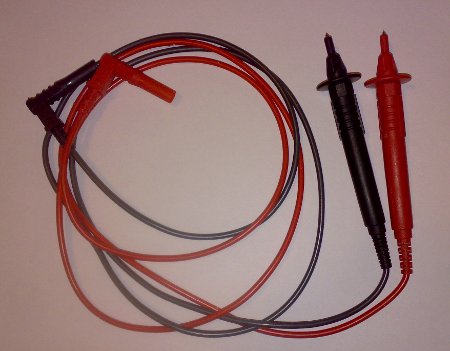
The product came in a simple plastic bag. A professional product does not need any fancy package.
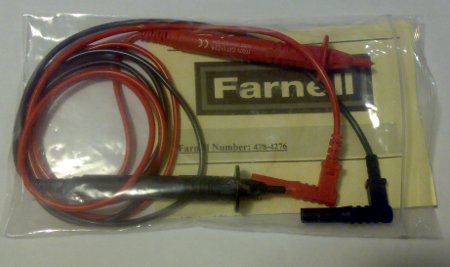
The bag contained the test probes and one paper that tells the most important product technical details (some more details can be found from Technical Data Sheet).
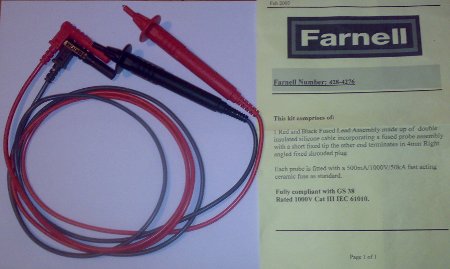
SILVERTRONIC – 131247 – TEST LEAD SET is rated 1000V CAT III IEC61010. Each probe is fitted with a 500 mA/1000V/50kA fast acting ceramic fuse as standard. The probe documentation paper says that “lead set have built-in fuses for additional measurement protection” and the probes are fully compliant with GS38.
Fuse provides protection with a current limiting capability and and very high interrupting rating. The tested probes have suitable high breaking capacity (50kA) very fast acting (FF) fuses with low current rating (500 mA) housed in the probes themselves.
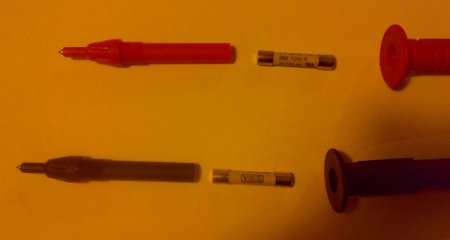
“Interrupt rating” (“breaking capacity”) refers to the maximum amount of instantaneous current that can be interrupted safely without explosion or damage. This interruption of current flow can occur in fault or short circuit conditions. Interrupting rating of fuses and breakers not be less than the maximum available short circuit current at their point-of-application.
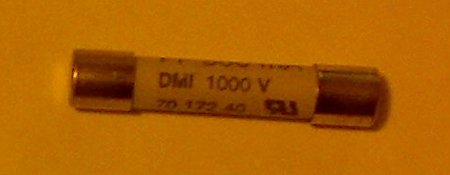
The 50kA interrupt rating is enough for very many electrical power applications. For example typical circuit breakers on home electrical panels have 5-6kA interrupt ratings and the short circuit currents considerable less than that. Typical fault currents in industrial applications can be well over 10,000 amps. The high interrupt capacity of the probes lies in hands of the supplied high breaking capacity 1kV 500mA 50kA fuses. If you happen to burn those fuses, use proper fuse replacements (do not try to put a “normal” 6.3×32 mm fuse there).
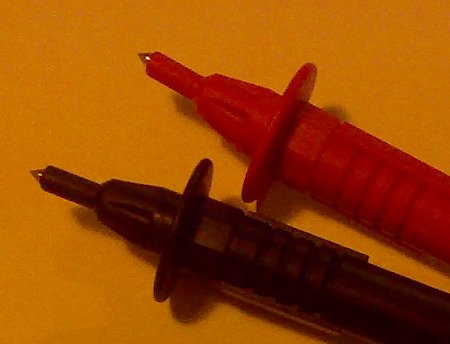
The bare tips on the supplied probes are short (around 2.5 mm) for a good reason. The 2.5 mm bare tip is well below that 4 mm GS 38 recommendation and shaped so that is pretty hard to make accidental short circuits with it. The probes being tested have good finger barriers guard against inadvertent hand contact with the live conductors under test. The probes feel good on the hand. Their handle are slightly thicker than in normal multimeter probes, which is not a bad thing at all. Otherwise they feel and measure pretty much the same as “normal” multimeter probes, they are just thicker.
The probe cables are insulated with silicon insulator and fulfill the double insulation requirements. The cable is very flexible which is very good thing (more flexible than cable on many “standard” multimeter probes).
One practical note that I found out then testing the probes is that the fuses inside the probes have some resistance in them. I found out that the multimeter resistance range showed 2.5 ohm loop resistance with the fused probes (versus zero ohms for original multimeter probes). If you plan to make resistance measurements with those probes, take this into account. The series resistance does not have any measurable effect on the voltage measurements.
The probes I tested seem to be good for what they are intended for. The price (29,68 €) seem to be reasonable because other similar probes seem to be cost at least the same or considerably mode (many other cost easily around 100 US dollars).
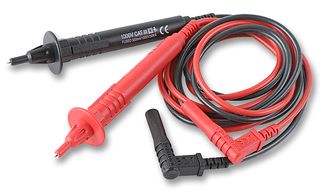

36 Comments
Chi Rooker says:
Learn from yesterday, live for today, hope for tomorrow.-Einstein
Marjorie Tomerlin says:
Circuit breaker designs these days are even more reliable and packed with more features.”
<a href="Please do have a look at our new website
http://www.melatoninfaq.com/melatonin-dosage/
John Opris says:
I am trying to find the documentation from the ESA(or somebody) that supports the use of fused test leads.
I would like the exact ruling on this, I cannot find anything except that manufacturers are complying with the Ontario ESA requirements for fused test leads.
tomi says:
http://www.robertson-electric.com/test-leads.htm page says:
As a result of the investigations into multimeter incidents, ESA commissioned a series of tests to simulate the impact of using fused leads as a protective measure. Fused leads used with multimeters prevented possible catastrophic results when the meter was used in an inappropriate way or experienced an internal failure.
Links to ESA brochure:
http://www.robertson-electric.com/pdfdocs/Multimeter_Brochure.pdf
http://www.esasafe.com/pdf/Multimeter_Brochure.pdf
Dave says:
Hmmm, ok for general work, but these wouldn’t be great for current measuring meters as they are only rated to 500mA. You can get larger ones (10A), though you may end up paying more for the leads than the meter. They are also more bulky. Personally prefer to buy multimeters than come with good quality HRC fuses and solid input protection as standard (along with nice silicone leads), such as what Fluke or Brymen put out. People buying cheap meters typically wouldn’t be interested in spending more than the cost of the meter on leads. Sadly, safety is often overlooked.
John says:
Nice product. Thanks for sharing this useful information with us.
https://supplyexpert.ca/
Tomi Engdahl says:
Having fun with fuses (short circuit)
https://www.youtube.com/watch?v=V-lhVTDWjwY
Alex Ferdenz says:
Useful information. Learn some new thing about the probe.
Michael says:
thank your for sharing with us this great article. It is a please for me to follow you.
Tomi Engdahl says:
EEVblog #376 – Multimeter Fuse Diode Followup
https://www.youtube.com/watch?v=ne_Prn0eGQE
How diode bridge protection across a shunt resistor in a multimeter works, and why the fuse blows before the diode does on a well designed multimeter like the Fluke.
Tomi Engdahl says:
Dangerous Multimeters (+ Explosion, Smoke & Fire)
https://www.youtube.com/watch?v=AjtoIRclid8
Sharing my explosive experiences with dangerous multimeters and recreating the explosion of the probe that originally exploded inside my hand. Some multimeters can’t handle mains voltage on some ranges, despite the manual claims they should. They often claim maximal voltage to be 500 to 1000V, despite the fuse is rated only 250V. The cables have very thin copper core, despite being rated 10 or even 20A. In use, they get very hot. As the cables of the multimeter are frequently used and are exposed to bending, the copper core slowly breaks, until just few hairs remain. This mostly happens where the cable leaves the probe. Then you measure a high current (like 10A) and the cable just EXPLODES!!! This is exactly what happened to me while measuring the current of a 230V 10A load. The multimeter probe exploded in my hand and miraculously only burned me but it didn’t electrocute me.
Tomi Engdahl says:
Blowing Fuses in Slow Motion
https://www.youtube.com/watch?v=qgz1lskyYDU
Blowing 0.75, 2.5, 4 and 6 amp glass fuses. Filmed at 1200fps
shaon says:
You just busted the myth that “the fuse blow the last one! “(old Romanian electronics myth). Thank you for this nice article!
Tomi Engdahl says:
https://www.electronicdesign.com/power-protection/5-high-voltage-fuses?utm_rid=CPG05000002750211&utm_campaign=30259&utm_medium=email&elq2=9341d644887f46babca0535e22e3ed4f&oly_enc_id=0452E0081834E9U
Enrgtech says:
Enrg Tech is UK’s leading Authorized electronic components distributors. Has millions of electronic components and offers same day shipping. New components added daily..The biggest store of electronic, electrical components and spare parts Search and find anything you need
rachel says:
This article is really interesting and useful. Thanks for this great blog. keep sharing such a nice article.
https://safetygearslab.co.uk/
Sofia joy says:
REALLY WELL EXPLAINED “Fused multimeter probes” I m also a professional electrical engineer and recently my research and all things related to multimeter tools. Appreciated your efforts Good Luck.
MultimeterTools says:
Amazing and step by step all explained…!!!
Best Multimeters 2022 says:
Really Impressed!!! Very well explained. Hopefully I will get any newly updated article about Top Best Multimeters 2022. Thanks
Best multimeter under $50 says:
If you are looking for the best multimeter under $50 you can visit for top 10 best multimeters under $50 in 2022 : https://multimetertools.com/best-multimeters-under-50/
Maria Taylor says:
Like This Content Thanks For Information.
Tomi Engdahl says:
Blowing a high voltage fuse
https://www.youtube.com/watch?v=K0-9ivSyz9Y
I found this high voltage fuse on the transformer in a microwave. It seemed a good idea to blow it for educational reasons.
Note that most modern home-microwave magnetrons do not use beryllium oxide insulators, despite the negatarian folklore. But always play safe and assume the worst.
Tomi Engdahl says:
The sand cools the vaporized metal that happens when the fuse blows. This prevents the vaporized metal from becoming ionized and allowing an arc to continue carrying current after the fusible metal link has melted. Sand is usually used in higher amperage fuses (30+ amps) and in fuses for higher voltages (480V and up).
Tomi Engdahl says:
JZDZ 2PCS Multimeter Test Stick Safety Non-Destructive Wire-Piercing Probes With 4MM Jack Puncture Test Hook Tool J.30036
https://www.aliexpress.com/item/1005004523584420.html?src=criteo&albch=criteo_New&acnt=criteo-LF&albcp=157651&device=pc&clickid=650052f8a3a3a08acc9c9096ee2414b9_1694520056_1005004523584420&aff_fcid=a2d1d12047fd4069a6876e4774d52130-1694520099351-09616-UneMJZVf&aff_fsk=UneMJZVf&aff_platform=aaf&sk=UneMJZVf&aff_trace_key=a2d1d12047fd4069a6876e4774d52130-1694520099351-09616-UneMJZVf&terminal_id=a84dd682a66047c694dfe5628f2eb974&afSmartRedirect=y
QSS Insulation Puncture Probe Wire-Piercing Test Hook Clip Spring Tool Automotive Diagnostic Tester Tool Q.30022
https://www.aliexpress.com/item/1005004406919350.html?spm=a2g0o.detail.0.0.3f515FzP5FzP8C&gps-id=pcDetailTopMoreOtherSeller&scm=1007.40000.327270.0&scm_id=1007.40000.327270.0&scm-url=1007.40000.327270.0&pvid=b2665a33-7180-4985-8c42-edf30f7480bd&_t=gps-id:pcDetailTopMoreOtherSeller,scm-url:1007.40000.327270.0,pvid:b2665a33-7180-4985-8c42-edf30f7480bd,tpp_buckets:668%232846%238111%231996&pdp_npi=4%40dis%21EUR%213.69%212.66%21%21%2128.27%21%21%402101ef7016945203377483755e6720%2112000029069031304%21rec%21FI%212528467667%21S&search_p4p_id=202309120505377862945012172706262496_0
Tomi Engdahl says:
2PCS Insulation Wire Piercing Puncture Probe Test Hook Clip with 2mm/4mm Socket Automotive Car Repair
https://www.aliexpress.com/item/1005004983080756.html?spm=a2g0o.detail.0.0.3f515FzP5FzP8C&gps-id=pcDetailTopMoreOtherSeller&scm=1007.40000.327270.0&scm_id=1007.40000.327270.0&scm-url=1007.40000.327270.0&pvid=b2665a33-7180-4985-8c42-edf30f7480bd&_t=gps-id:pcDetailTopMoreOtherSeller,scm-url:1007.40000.327270.0,pvid:b2665a33-7180-4985-8c42-edf30f7480bd,tpp_buckets:668%232846%238111%231996&pdp_npi=4%40dis%21EUR%217.00%214.2%21%21%2153.59%21%21%402101ef7016945203377483755e6720%2112000031235170246%21rec%21FI%212528467667%21S&search_p4p_id=202309120505377862945012172706262496_1
Tomi Engdahl says:
https://e-z-hook.com/blog-guide-to-insulation-piercing-connectors-and-test-leads/
How to use Wire Piercing Probes
https://www.youtube.com/watch?v=sw72QmpL3fM
Wire Piercing Probes usage and the need for Liquid Electrical Tape
Tomi Engdahl says:
2pcs Insulation Wire Piercing Puncture Probe Test Hook Clip Car Line Inspection Probe with 2mm/4mm Socket Auto Repair
https://www.aliexpress.com/item/1005004683291926.html?spm=a2g0o.detail.1000014.28.7c743K4S3K4SQB&gps-id=pcDetailBottomMoreOtherSeller&scm=1007.40000.326746.0&scm_id=1007.40000.326746.0&scm-url=1007.40000.326746.0&pvid=add16aa3-c5bc-41c6-8835-93c2346cbb8a&_t=gps-id:pcDetailBottomMoreOtherSeller,scm-url:1007.40000.326746.0,pvid:add16aa3-c5bc-41c6-8835-93c2346cbb8a,tpp_buckets:668%232846%238111%23456&pdp_npi=4%40dis%21EUR%214.48%212.24%21%21%214.70%21%21%402101ef7016945206652412525e6720%2112000030087871021%21rec%21FI%212528467667%21S
Tomi Engdahl says:
Multimeter Test Leads Quick Connect Plug 4mm Gun Lantern Head Welding Free Wiring Socket High Quality No Multimeter Connector
https://www.aliexpress.com/item/1005004450689604.html?spm=a2g0o.detail.0.0.7c743K4S3K4SQB&gps-id=pcDetailTopMoreOtherSeller&scm=1007.40000.327270.0&scm_id=1007.40000.327270.0&scm-url=1007.40000.327270.0&pvid=58e785e2-1bdb-4f19-a48e-a68fef349388&_t=gps-id:pcDetailTopMoreOtherSeller,scm-url:1007.40000.327270.0,pvid:58e785e2-1bdb-4f19-a48e-a68fef349388,tpp_buckets:668%232846%238111%231996&pdp_npi=4%40dis%21EUR%213.00%212.25%21%21%2122.96%21%21%402101ef7016945204850526685e6720%2112000029221026744%21rec%21FI%212528467667%21S&search_p4p_id=202309120508050852253765825959678016_3
Tomi Engdahl says:
TPC132 2mm Female Plug to Internal Spring Test Hook Probe 22AWG Test Lead Kit Can connect the Digital Multimeter Probe
https://www.aliexpress.com/item/4000924113279.html?spm=a2g0o.productlist.main.7.3df26b29KVqUYq&algo_pvid=2b59a378-1c78-4a2d-ab3b-18f806770059&aem_p4p_detail=202309120521422208595717210000000254544&algo_exp_id=2b59a378-1c78-4a2d-ab3b-18f806770059-3&pdp_npi=4%40dis%21EUR%214.68%214.44%21%21%214.91%21%21%402103241116945213024823430e060b%2110000011225800534%21sea%21FI%212528467667%21S&curPageLogUid=P8C6ztJBkaCX&search_p4p_id=202309120521422208595717210000000254544_4
Tomi Engdahl says:
JZDZ 5pcs Test Probe Full Insulation Safety Piercing Test Pin 4mm Banana Plug Non-destructive Pucture Needles Set J.30009H
https://www.aliexpress.com/item/1005002718178694.html?spm=a2g0o.detail.0.0.7c743K4S3K4SQB&gps-id=pcDetailTopMoreOtherSeller&scm=1007.40000.327270.0&scm_id=1007.40000.327270.0&scm-url=1007.40000.327270.0&pvid=58e785e2-1bdb-4f19-a48e-a68fef349388&_t=gps-id:pcDetailTopMoreOtherSeller,scm-url:1007.40000.327270.0,pvid:58e785e2-1bdb-4f19-a48e-a68fef349388,tpp_buckets:668%232846%238111%231996&pdp_npi=4%40dis%21EUR%214.37%213.27%21%21%214.58%21%21%402101ef7016945204850526685e6720%2112000021857384165%21rec%21FI%212528467667%21S&search_p4p_id=202309120508050852253765825959678016_8
Tomi Engdahl says:
Multimeter Probe Hook 4mm Threaded Socket Smd Ic Clamp Spring Damage Test Gilding Suitable For Test Lead 2mm/4mm/M4 Interface
https://www.aliexpress.com/item/1005004148928093.html?spm=a2g0o.detail.1000014.47.62a1d5btd5bt9D&gps-id=pcDetailBottomMoreOtherSeller&scm=1007.40000.326746.0&scm_id=1007.40000.326746.0&scm-url=1007.40000.326746.0&pvid=016d290d-e0de-4140-9ef0-a805965b8d09&_t=gps-id:pcDetailBottomMoreOtherSeller,scm-url:1007.40000.326746.0,pvid:016d290d-e0de-4140-9ef0-a805965b8d09,tpp_buckets:668%232846%238111%23456&pdp_npi=4%40dis%21EUR%214.68%213.61%21%21%2135.87%21%21%402101c5b116945239607832542e56be%2112000031384142770%21rec%21FI%212528467667%21S
Tomi Engdahl says:
Breaking Capacity of 5x20mm glass fuse is typically at 35 A – 200 A range, while the current that you can get at full short circuit from normal 230V mains outlet can be easily 400A or more.
Tomi Engdahl says:
Other probes:
1000V5A Multimeter Test leads Magnetic Probe Suitable For Digital Multimeter Megohmmeter
https://www.aliexpress.com/item/1005005695355110.html?src=criteo&albch=criteo_New&acnt=criteo-LF&albcp=157651&device=pc&clickid=6511997f34ca0646795bb8c08c407996_1695652223_1005005695355110&cto_pld=5bDWG8LKAAAtsazaty9JVA&aff_fcid=d816d07b97cb437fbca344947da32a40-1695652226738-09032-UneMJZVf&aff_fsk=UneMJZVf&aff_platform=aaf&sk=UneMJZVf&aff_trace_key=d816d07b97cb437fbca344947da32a40-1695652226738-09032-UneMJZVf&terminal_id=a84dd682a66047c694dfe5628f2eb974&afSmartRedirect=y
Multimeter Test Leads Quick Connect Plug 4mm Gun Lantern Head Welding Free Wiring Socket High Quality No Multimeter Connector
https://www.aliexpress.com/item/1005004450689604.html?spm=a2g0o.detail.0.0.60a5EZxOEZxOT0&gps-id=pcDetailTopMoreOtherSeller&scm=1007.40000.327270.0&scm_id=1007.40000.327270.0&scm-url=1007.40000.327270.0&pvid=a4a8c262-5406-4eaa-b46b-d0f9e7f0e546&_t=gps-id:pcDetailTopMoreOtherSeller,scm-url:1007.40000.327270.0,pvid:a4a8c262-5406-4eaa-b46b-d0f9e7f0e546,tpp_buckets:668%232846%238111%231996&pdp_npi=4%40dis%21EUR%213.02%212.27%21%21%2122.96%21%21%402103200616956522278098400e1296%2112000029221026747%21rec%21FI%212528467667%21&search_p4p_id=202309250730278546473392521891621763_6
Tomi Engdahl says:
Magnetic probe tips:
https://www.fluke.com/en/product/accessories/probes/fluke-mp1-magnet-probe-1
https://fi.farnell.com/en-FI/hioki/l4937/magnetic-adapter-set-test-lead/dp/3262349
https://thecalibrationcentre.co.uk/product/magnetic-test-lead-probe-adaptors/
https://www.amazon.com/magnetic-test-leads/s?k=magnetic+test+leads
https://www.aliexpress.com/i/1005001762677686.html
https://www.fruugo.fi/6pcs-magnetic-test-leads-silicone-soft-flexible-jumper-test-wires-30vac-5a-33ft-t10005-sensors-swi/p-137754620-290749580?language=en&ac=croud&asc=pmax&gclid=CjwKCAjw38SoBhB6EiwA8EQVLgWDdSxQPefmq0WsGegbJDyW5vPJsM1GUr_QPoUPapGhNej8ody4qxoC_O0QAvD_BwE
Tomi Engdahl says:
https://www.swe-check.com.au/pages/learn_fuse_speed.php
Tomi Engdahl says:
Fuse inspection
https://youtube.com/shorts/WCYBHFgHNb8?si=facjgxRVAfQMudmA